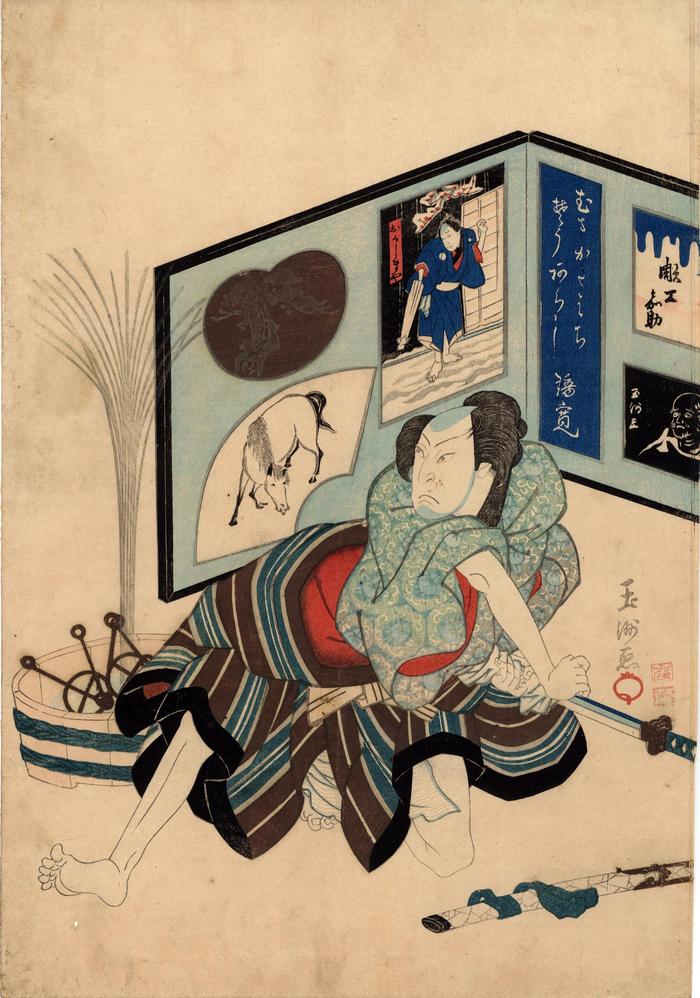Gyokushū (玉洲) (artist )
Arashi Rikan II (嵐璃寛) as the umakata (packhorse driver - 馬方) Hachizō (八蔵) in the play Keisei Somewake Tazuna (けいせい染分總) or 'A Courtesan's Reins Dyed in Different Colors'
01/1834
10.25 in x 15 in (Overall dimensions) color woodblock print
Signed: Gyokushū ga (玉洲画)
Carver: Kasuke (彫工嘉助) - signed on the
upper right sheet on the screen
Hankyu Culture Foundation
Tokyo Metropolitan Library - 1881 Chikanobu triptych including the Hachizō character in a dramatic scene
Museum of Fine Arts, Boston - Hirosada of Sankichi in the snow with an umbrella
Lyon Collection - print of the tobacconist Sankichi by Shunkei While Hachizō is about to kill himself one can find all of the pertinent information about this print on the screen standing behind him.
Gyokushū's signature appears twice. One time is next to the image of Daruma applied to the screen in the lower right. To the left of it is an attached poem scroll with the name of the actor, Rikan.
On the left side of the screen is a print of a man standing in the snow. He is Sankichi, the tobacco trader who is also a character in this play. The horse painted on the fan indicates that this work must be from 1834, the Year of the Horse.
****
This print illustrates a scene from the play Keisei Somewake Tazuna. This is brought home by the image of the figure with the umbrella in snow on the screen behind Hachizō. The figure represents Sankichi, the tobacco seller. (See the link to the Hirosada print at the Museum of Fine Arts in Boston.)
****
In a 1708 play by Chikamatsu, translated by Donald Keene, the character of Hachizō makes his appearance. In the first act packhorse drivers are used to accompany the daughter of a lord on her bridal journey. It says: "The drivers of the thirty horses are accomplished ballad singers, chosen, with no expenses spared, for their good looks and fine voices."
Keene notes that Hachizō's name includes the kanji for bee (蜂). In one scene he is described as buzzing (or humming, by extension) as he approaches. Since packhorse drivers were known to be good singers Hachizō's name strengthens this point.
Another reinforcing motif is the pair of umakata or horse bits lying in the vat slightly behind the figure of Hachizō. Also, one has to wonder if the chose of design elements has any particular significance: two fans, one with a portion of a pine tree, the other a horse,; an actor standing barefoot in the snow at night holding a closed umbrella; two poems; and an image of Daruma.
The actor Arashi Rikan II kneeling as he cleans his sword blade - or is about to commit seppuku.
Nothing seems to be recorded of this Osaka artist who was, presumably, a pupil of Hokushū.
****
Illustrated:
1) In color in 原色浮世絵大百科事典 (Genshoku Ukiyoe Daihyakka Jiten), vol. 2, p. 25.
2) In color in Schätze der Kamigata: Japanische Farbholzschnitte aus Osaka 1780-1880, MNHA (Musée national d'histoire et d'art Luxembourg), 2012, p. 142, #75. The catalog entry reads: "Umataka Hachizo begeht Seppuku. Auf diesem Blatt stehen wichtige informationen als Malereien auf dem Stellschirm."
"Oben rechts in Form einer Signatur der Holzschneider Kasuke (Hiroko Kasuke), darunter ein Daruma-Bild mit der Signatur Gyokushu ga, links davon in Form eines Gedichts Rolle und Name des Schauspielers."
"Der Holzschnitt auf dem linken Teil des Schirms zeigt den Tabakhändler Sankichi, eine der Hauptfiguren des Stückes, im Schnee. Das Pferd auf dem Fächer weist auf das Jahr des Pferdes (1834) hin."
The Google translations is: "Umataka Hachizo commits seppuku. This sheet contains important information as paintings on the control screen."
"Top right in the form of a signature of the woodcutter Kasuke (Hiroko Kasuke), below a Daruma picture with the signature Gyokushu ga, on the left of it in the form of a poem the role and name of the actor."
"The woodcut on the left part of the screen shows the tobacconist Sankichi, one of the main characters of the play, in the snow. The horse on the fan refers to the year of the horse (1834)."
****
There is an 1881 Chikanobu triptych in the Tokyo Metropolitan Library that includes the packhorse driver Hachizo in it. One site describes the scene as "...the nursemaid Shigenoi, shown at center holding a tray of sweets and frowning slightly as she looks down at pack horse driver Hachizō and his son, Sankichi. She has just discovered that Sankichi is the child she was forced to give up at birth. Sadly, because of her high position taking care of the Princess Shirabe, she can never be a real mother to him and decides not to reveal her secret."
Arashi Rikan II (二代目嵐璃寛: 9/1828 - 6/1837) (actor)
Kyōto-Osaka prints (kamigata-e - 上方絵) (genre)
actor prints (yakusha-e - 役者絵) (genre)
Chikamatsu Monzaemon (近松門左衛門) (author)
